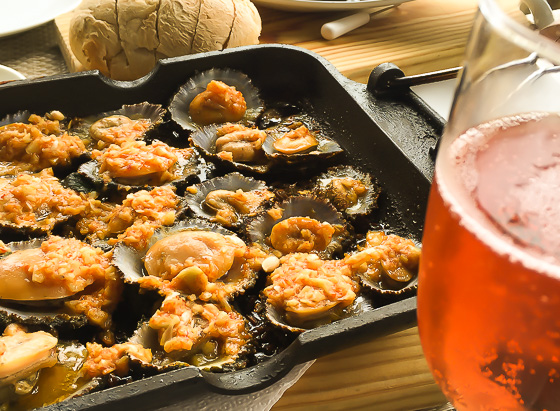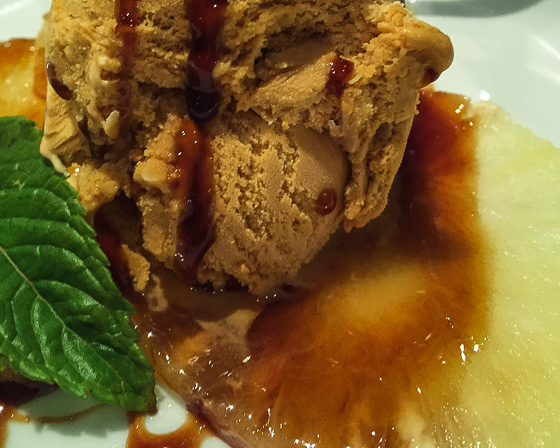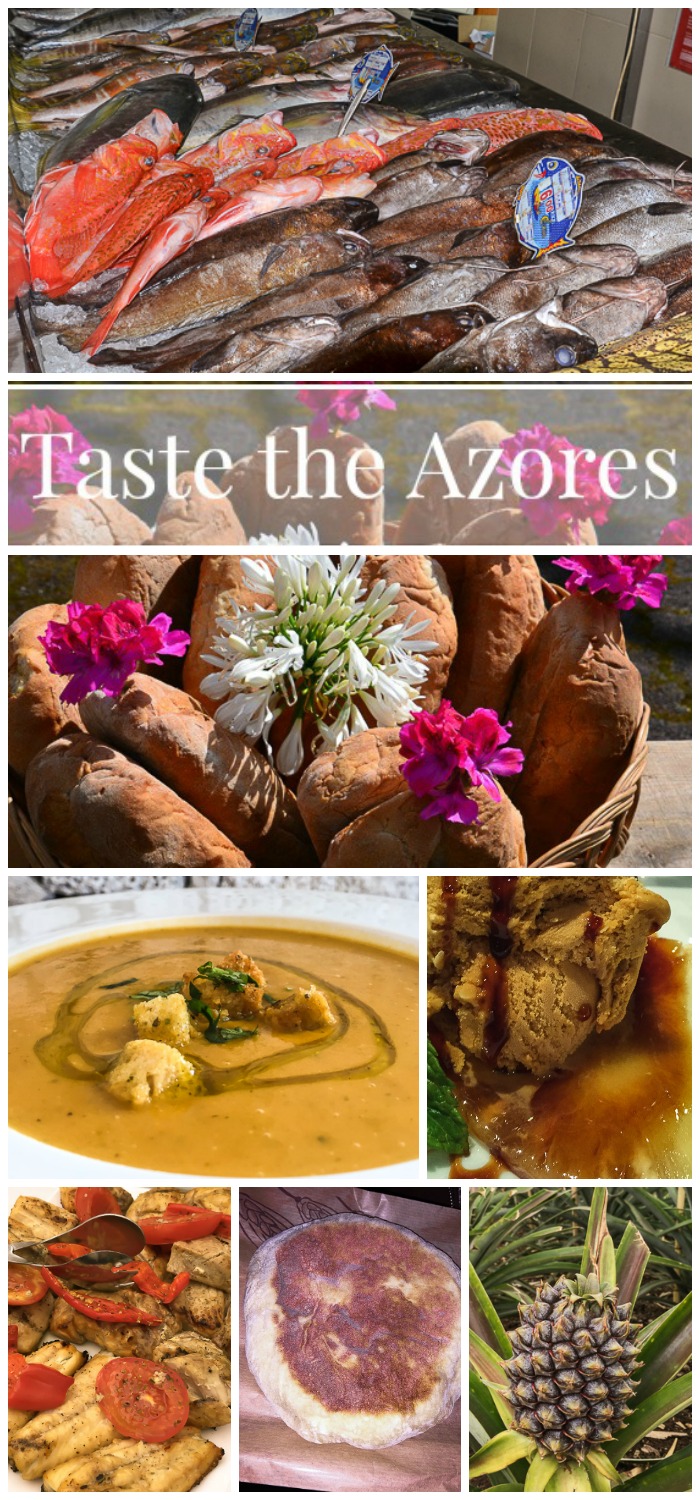10 Ways to Taste the Azores
When you travel the Azores, you quickly become aware of the role island living plays in the food chain. The sea surrounds all of the archipelago and the soil is volcanic. Thousands of years of eruptions have left behind a green wonderland filled with hot springs, lakes ranging in shades from xanadu to smagagdine and the azure blue waters of the ocean around every winding road. Currents, migrating birds and sailors have all contributed to the unusual bounty of unique foods you’ll find when you have a chance to taste the Azores.

With a population hovering around 250,000 people, the residents of the Azores were eating local long before it was a trendy foodie term. Anything that wasn’t of the land and sea had to be imported from the mainland at great cost. Isolation and a lush and green environment have played a roll in the flavors of the Azores. Fish is a large part of the diet, more so than in the rest of Portugal, as the ocean floor surrounding the islands provides a rich environment for creatures of the sea to thrive. Red snapper, bluefish, sardines, mullet and tuna are all abundant and beautifully displayed at the local markets. The fish mongers will be sure to tell you just how fresh their catch is!
As a pescatarain, I was a little concerned pre-trip, as I knew much of Portuguese cuisine revolves around meat. My fears were quickly put at ease, I was in my wheel house and could not believe the selection and variety I found on each and every menu. After choosing the fresh fish from the display at one of the many fine restaurants we encountered. The family style platter of simply grilled fish, accented with only salt, pepper and lemon, lets the true tastes shine through of the tuna, barracuda, sea bream and grey mullet we had selected just a short time before.
Despite new fishing technologies and advanced methods that are used all around the world, the tuna commercial fleet of the Azores still operates with pole and line making it a truly selective and sustainable fishery (It is certified as a “Friend of the Sea” fishery, since 2001).
In fact, this fishery is divided in two stages, the first stage being the capture of small pelagic fishes, the live bait, that fishermen keep aboard in water tanks so they can use it later to capture tuna. The irregular sea floor from all of the volcanic activity provides copious breeding grounds for the anchovies and sardines for which this area of the world is well known.
Azores, Pico-Cella Bar’s fish soup
The abundance of seafood guarantees the appearance of fish soup in many different variations and I found each restaurant had their own version of the popular dish. The top version was a smooth velvety soap de piexe á cella from the most gorgeous restaurant I visited during the trip, Pico’s Cella Bar.
On the island of Terceira, the food options were many and all as delicious as they were unusual. This modern take on the traditional fish soup had a base at the bottom of the bowl made from bread mixed with shrimp and fish eggs. Squid, octopus and grilled bonita were placed on top with an accent of what they called ice plant. Although it was indeed a succulent, it differed from the ice plant we have in the states. This one is called the crystalline ice plant and grows low in coastal areas. The leaves almost dissolve in your mouth with a very liquid experience, at once surprising and refreshing. The soup was abundantly rich and could have easily served as my main course.

Azores, Terceira-Angra do Herosimo, Cais de Angra Restaurant
The more I travel, the more experimental I find myself with food. I was familiar with the jagged shell of the limpet, but had never before encountered them on the menu. Being a clam lover, they were an easy sell. Add in a butter and garlic sauce, served table side in a steaming hot skillet and the three of us could not get them in fast enough. Chunks of Portuguese bread (as in the feature photo) are handy for soaking up all the leftover sauce and niblets left in the bottom of the pan. Come to find out that limpets are actually an aquatic snail with only one shell, which made no difference to anyone but my traveling partner who was horrified to learn she had eaten a gastropod, but still managed to devour a few additional snails later in the trip!

Azores, Terceira-Angra do Herosimo, Cais de Angra Restaurant
The next selection was a bit more challenging. I had read about barnacles being a specialty in my pre-travel research. Seeing them on a plate was a little different, but I suppose appropriate here in the Azores, as they looked like little miniature volcanoes. Pretty indeed, dressed in many shades of green, but I was unsure. Turns out, after getting the hang of removing the meat from the shell with a teeny ice pick, the first thing that came to mind was crab, which made sense as they are an arthropod and related to crabs and lobsters.

Azores, Terceira-Angra do Herosimo, Cais de Angra Restaurant Barnacles
Just because I know many of you are wondering, I thought I’d also share that most are hermaphroditic. The barnacles often find themselves displaced in the shallow waters by limpets and mussels which compete with them for space. Cooked in sea water, the liquid remaining in the shell is a bit of a delicacy, and should be carefully savored, quite difficult to manage without slurping.

Taste the Azores, Faial-Genuino Restaurant
Then, on the island of Faial, there were the meatballs. I admit, I probably would have liked anything to come out of this man’s kitchen. After all, the guy circumnavigated the globe not once, but twice-BY HIMSELF no less; I was kind of in awe before we stepped foot in the restaurant.
Why are people like myself, that don’t eat meat, always trying to find something that is meaty? I say the same things about portabello mushrooms, one of the meatiest treats I can grill up these days. Perhaps we are secretly craving past meals, but I tend to believe it’s just a point of reference. These balls were fish, tuna fish balls to be exact, and delicious. Served on a bed of pureed minhostos, the small yams were the perfect sweet compliment to the savory tuna.

Taste the Azores-São Jorge cheese .
You’ll find cows dotting the islands of the Azores, feasting on the green grass carpeting the volcanic rocks. The high quality milk they produce makes for some mighty find cheese and ice cream. The island of São Jorge has been producing their famous cheese for centuries. The raw milk is aged for at least three months and the semi-hard yellow cheese is served as a starter at many restaurants. The flavor was stronger than most of the other cheeses I tasted, with hints of the land the milk comes from. Served with Portuguese rolls, it is full of flavor for breakfast, lunch or dinner.

Bolo levedo, traditional Portuguese sweet bread
Returning to the hotel late one afternoon on São Miguel, our guide Sandra asked if she could make a quick pit stop on the way. When she re-entered the van, the aroma of freshly baked bread immediately filled the space. I don’t know of a scent that can have more of an effect on your taste beds than this one. Similar to an english muffin and cooked on a griddle, the warm bolo lêvedo (leavened cake) from Furnas is made daily in limited supply in a small bakery behind a simple house on a charming street. You would never know it was there, but once you knew, you would never forget. No accompaniment necessary, but I am certain butter and the Azores floral honey might elevate it into the otherworldly realm. Sandra kept checking to make sure we were’t getting into more of her stash, and believe me when I say it was hard to resist. Although the photo wasn’t necessary for the memory, it motivated me to locate the bolo here in Massachusetts. There is a large Portuguese community in nearby Fall River and I can’t wait to try and recreate the experience and aroma.

Pineapple farm in São Miguel
Azorean pineapples are smaller and packed with a sweetness that is hard to describe. The plant was originally brought to the area as an ornamental species, but a clever farmer realized its potential as a crop. The islands are not tropical, so the plants are grown in greenhouses. Sugars are concentrated and ripening hastened by a smoking process that allows for simultaneous flowering and controlled growth. The end result is a fruit used in many dishes, made into jams as well as a tasty pineapple liquor.
Each pineapple takes two years to mature, and is worth the wait. Pineapple carpaccio anyone? Topped with a rich and creamy caramel ice cream, it makes a satisfying desert. A slice alone of the almost candy like sweet fruit is the perfect finish to a meal.
Sweets brings out a number of ways to taste the Azores local flavors. Milk, eggs, butter, flour, and a bit of floral honey are all the ingredients a bakery needs. Dusted with with powdered sugar and wrapped in crisp white paper that mimics a starched ruffled collar, the regional treat of Terceira, donas amelias are a cake laced with what I would call New England frugality. It is rumored that the recipe originally comes from the convents. Nuns would use egg whites to starch clothing, and not wanting to waste the yolks, developed cake recipes to use the remaining yellow gold. Each island has their own speciality and the Dona Amelia was named for Queen Amelia after her royal visit in 1901 with her husband King Carlos.
At the end of my trip, I discovered in a sleek waterfront restaurant, Anfiteatro’s,the embodiment of the unusual food contradiction found in this remote destination called the Azores. Here, a teaching, work/study environment, part of Ponta Delgado’s hospitality school, is raising the stakes on what it means to be a part of the restaurant community on the archipelago. Loaded with natural resources and local ingredients, fishmongers and artisan cheese and winemakers rub shoulders with gourmet chefs to elevate the expectations of diners in unexpected ways.
♥ Pin Me-Taste the Azores
OR ME
My travel to the Azores was generously sponsored by Visit Azores, but as always, opinions are my own.














































Everything looks delicious! Interesting to read they still use the pole fishing method for commercial tuna!
They really are focused on keeping the seafood industry sustainable here Jessica. I hope they can maintain in for the long term.
You’ve taken me back to some wonderful places with this post, especially the Terra Nostra Gardens. Next time I go to the Azores I am definitely going to have to be more adventurous with the seafood. It looks amazing! And I’m super jealous that you’ve been to Celar bar. It’s definitely on my list.
I surprised myself Julie, and am not sure how I ever got the nerve to eat the barnacle. A spell came over me and I didn’t want to miss any of the flavors. It taught me a good lesson.
OMG I am just salivating looking at these scrumptious photos! Truly a feast for multiple senses. The Azores look like a fantastic destination for pesca-, carni- or vege- foodies alike!
Food was remarkable Betsy and would certainly satisfy all taste buds. I was a little nervous as I knew the “meat” reputation of the area. Never was an issue. The seafood is out of this world!
What a wonderful posting! I so want to taste the Azores now that I have seen your photos and read your article. It is going on our priority list! Thanks for such an inviting article!
Glad to hear you enjoyed it Denis. The Azores is a hidden gem!
It is really a wonderful place Denis, especially if you like off the beaten path and outdoor activity!
Wow!!! I wanna go there soon:)A road less traveled indeed… My in laws have visited this island and they love it:)
My mouth was watering again looking at these photos from the Azores! You really captured a lot of the unique texture, e.g. the iceplant, the barnacles, and the blood sausage. Can we go back?
You would not have to ask me twice. How fast can you pack your bags!
What a delightful post, Alison! You had me salivating all the way. Until we got to the barnacles!!! And then the blood sausage truffle??? Apart from those, I am now wanting to taste the Azores for myself.
Oh my goodness! What an amazing selection of mouthwatering food! I am always in awe of food writers and you did a great job of describing every morsel! I’d love to experience the Azores and have a few of these delicious-looking meals myself.
Delicious. I want to go to the Azores.